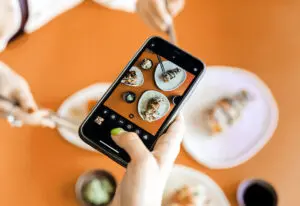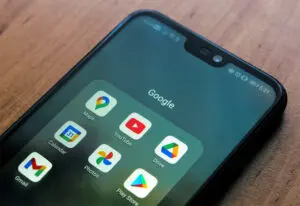
The Power of Peers: Should Your Brand Have an Influencer Marketing Strategy?
Think back to when you were a teenager. There was probably a time when your parents asked you to do something, like get a haircut or study for your driver’s test. You might have scoffed at their suggestion and moved on to the next thing. But, if your friends made the same suggestion that day, you’d nod and think, What a great idea. We feel the strength of peer influence from an early age, which carries over into how we interact with the world as adults—including the brands we trust and follow. For modern brands, influencer marketing has now taken center stage for peer recommendations. So, is it worth having an influencer marketing strategy? We think so!
The Rise of the Influencer
If this was a pop quiz and we asked when you thought influencer marketing began, what would you say? Probably on the same trajectory as social media, right? Actually, no. The earliest recorded version of this marketing was in 105 BCE in Ancient Rome, where gladiator billboards promoted events using famous fighters. Influencers have taken on many roles and faces throughout history, from queens to fabricated characters to regular Joes and Janes.
Over its long history, it’s remained a boots-on-the-ground approach that takes the brand from its pedestal and puts it among the people—or, rather, the customers. Modern influencer marketing is tied to the rise of social media, where it takes the timeless principle of peer influence for an online-to-IRL approach.
Know the Lingo
Before we dive into what makes a good influencer marketing strategy, let’s define some of the terms you’ll need to know for this marketing.
Influencer: A person with a significant online presence and loyal social media following, typically in a niche or dedicated category (like fitness, beauty, sports, etc.). Mega equals 1M+ followers, and Macro equals 100K to 1M followers.
Micro-Influencer: A person with a smaller following (10K-100K) but one that’s highly engaged in a niche market. These people usually have more personal connections with their followers.
Nano-Influencer: A person with a highly focused but small (less than 10K) community.
Follower Count: The total number of people who follow an influencer on social media that’s used to quantify reach and audience size.
Engagement Rate: Percentage of an influencer’s social following who interacts with the content via likes, reshares, and comments.
Influencer Relations: Building relationships between your brand and influencers who fit your market niche and align with your brand goals.
Influencer Content Co-Creation: Working with an influencer to produce content with both parties contributing to the creative process.
Influencer-Generated Content (IGC): Similar to UGC, IGC is where an influencer takes the lead on the creative content within the brand partnership terms.
The Elements of a Good Influencer Marketing Strategy
Whether you want to start a long-term relationship with a brand ambassador or have a short-term fling with a social media star, it’s a good idea to have a solid influencer marketing strategy.
When done right, this type of marketing helps establish your brand more authentically within your target audiences, inspires purchases, generates leads, and sets your brand up for success.
To create a solid strategy, you need to:
Define goals, audience, & budget
You know we always come back to this one. When you grow a muscle, the end goal is definition. When you grow a brand, definition is the starting point. Like any good marketing strategy, you need to start with clear goals, audience sets, and overall budget.
If you (or your marketing agency) have done market research up to this point, you likely have a solid idea of basic audience demographics, including age range, interests, geographic area, and which social channels they spend the most time on. When creating an influencer marketing strategy, you can marry this data with your KPIs like increased sales, organic traffic, or follower growth.
These metrics, and your overall budget, will inform what type of influencer you’ll be able to work with. Keep in mind that influencers base their pricing on their follower count and engagement rate, so the higher both are, the higher the cost.
Establish an authentic brand partnership
Call it clout, call it cred—whatever the secret sauce, you need it in influencer marketing. Establishing a brand partnership that meets the trifecta of authenticity, relevancy, and effectiveness is crucial. We like to say that it’s equal parts research and gut. An influencer’s numbers and niche are important, but are they are good fit for your brand? Would it make sense for them to authentically communicate your brand values to their audiences? And, maybe most importantly, would their audiences care?
When you choose right, you could start a years-long relationship with someone genuinely passionate about your products or services. A mutually beneficial relationship like this does more for your brand awareness and loyalty than metrics alone. Plus, an influencer with the right communication style can speak to your audience on a human level that inspires trust.
Construct a helpful brief
A brief is to an influencer relationship as instructions are to a recipe. Without it, you’re cooking blind. Your brief will guide the content and help inform how the relationship functions, what messaging the influencer needs to be aware of (and stay away from), and the type of creative content required across channels.
As we mentioned above, you can go the route of co-creation or IGC, but either way, a brief will help guide the process so both parties are happy. It’ll also give you something to refer to when keeping influencers accountable and checking things are on track. One of the biggest pitfalls we see brands make is not giving their influencers enough creative freedom. If something feels scripted or gimmicky versus a natural partnership, their followers (your audience) will know right away. The takeaway? Create a brief to inspire, not restrict.
Track campaigns with the right metrics
Unsurprisingly, the end brings us back to the beginning. When tracking the metrics of your influencer campaign or ambassador partnerships, make sure you’re not focusing so heavily on the data that you forget to see the full scope of influence. Sure, conversions and revenue are important. But an influencer relationship can also positively impact engagement metrics, follower growth, inbound leads, and overall brand loyalty.
The Power of Peers
[box] A quick sidebar on why peer influence is so, well, influential. The idea of “social influence” started long before a tweet meant something other than a bird’s noise. People innately care what others think, which changes how they value different behaviors and ideas. The reward system in our brain is activated by receiving a compliment—which social media plays into with features such as likes and comments.
According to a recent Forbes article, it also has to do with humans’ natural pack mentality. When we see people we look up to—even if they’re far removed from us, like celebrities—we feel obligated to keep up with their activities and try to mirror their value systems. Social media influencers often come across as trusted experts to their followers. This, coupled with a personal connection, unconsciously makes us want to care and follow the pack. [/box]
We’ve Been Influenced
Influencer marketing is a dime a dozen these days. But these examples caught our eyes for their unabashed authenticity.
Domino’s & Elyse Meyers (TikTok)
If you don’t notify the TikTok community about a new product launch, is it even real? Popular TikTok influencer, Elyse Meyers, is known for her radical authenticity, humor, and relatability. Like most Mega Influencers, brand deals pepper her account. One such partnership was with Domino’s to help bring awareness to their new menu item: loaded tots. In the sponsored video, Elyse and her husband seamlessly create a humourous game out of trying to fit the most tots in their mouths. Instead of a dry sales pitch to the camera, Elyse created a marriage between their brand and hers.
Taryn Delanie Smith (Instagram/Stories)
Known for her lovable goofiness and comedic timing, influencer Taryn Delanie Smith has a dedicated following on TikTok and Instagram, where she creates post series that are part hilarity, part heartfelt connection. In her ongoing partnership with Lily Pulitzer, Taryn applied her “goblin energy” to the campaign and created a new series that had her followers asking for more. By remaining true to her style, she added value to the brand without coming across as sales-y.
The Barbie Movie (cross-channel)
We can’t leave this blog without talking about the influencer hype surrounding the Barbie Movie. Leading up to its release on July 21, the movie—backed by industry giant Mattel—used the full power of its influence. From Margot Robbie’s classic Barbie-inspired outfits with leading fashion designers to popular social influencers promoting the film, it, as Ad Age implied, represents a new era in movie marketing.
Ready to Build an Influencer Marketing Strategy? Savy Can Help
Let’s face it; humans are social creatures. It’s why we gravitate toward (and become addicted to) social media platforms that stoke our needs for attention, understanding, and a group that “gets” us. As a brand trying to stand out in the digital age, creating an influencer marketing strategy that brings your brand to life in the most raw, human, and credible way is worth the hype. Savy’s here when you’re ready to get started.
Recent Posts
Custom Website Design and Development vs. Off-the-Shelf: What’s Right for Your Business?
Having a website that represents your brand and serves your business effectively can make or break your success in 2025. This poses the important question: Should you opt for custom […]
Read MoreHow to Rebrand Your Instagram for Better Engagement and Brand Recognition
Your Instagram presence can act as a beacon for brand recognition and customer engagement. It’s about painting a picture so compelling that your audience cannot help but be drawn to […]
Read MoreFrom Clicks to Conversions: The Science of High-Performing Digital Ads
The journey from interest to purchase is often paved with digital advertisements. However, not all digital ads are crafted equally. While some fade into the background, others command attention and […]
Read MoreBrand Consistency Examples That Will Make You Rethink Your Marketing Strategy
A consistent and strategic brand identity across all platforms is not just beneficial; it’s essential. By exploring real-world brand consistency examples, we uncover the immense power of maintaining a coherent […]
Read More3 Ways to Transform Blogs With SEO and Make Google Love Your Content
As marketers and business owners, our goal is to ensure the blogs we publish confidently stride into the spotlight of Google’s top search results. Achieving this requires great content, but […]
Read More



